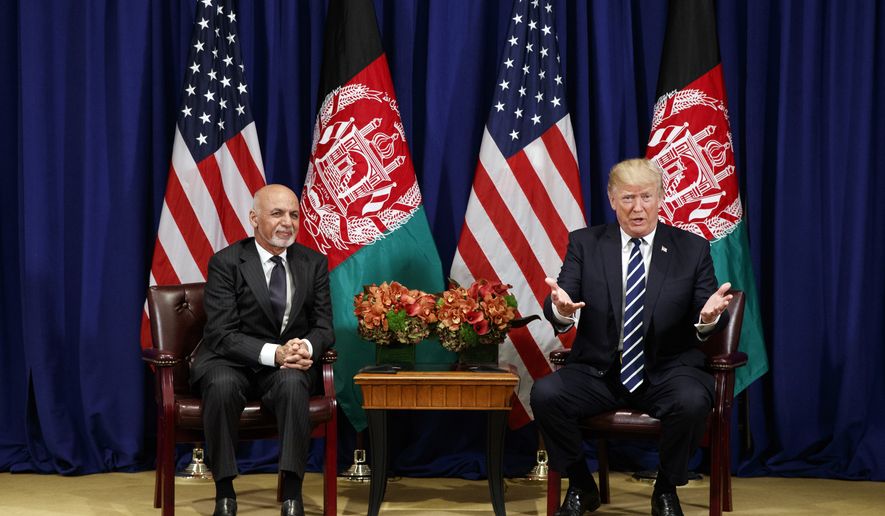President Trump’s new strategy for the Afghanistan War garnered a glowing review from the country’s leader Thursday, who said the difference on the ground after just four weeks was “night and day” from the war plan of the Obama administration.
Meeting with Mr. Trump on the sidelines of the U.N. General Assembly in New York, Afghanistan President Ashraf Ghani called the change in strategy “historic” and credited it with putting his country on a path toward victory over Taliban militants and other radical Islamic terrorists.
“You made this decision on the basis of courage and determination. We salute your courage,” he told Mr. Trump. “The cloud of uncertainty has been lifted, but equally important is your commitment to a political solution at the end of this process.”
Mr. Trump said every report he hears from Afghanistan reflects the new fighting spirit that has taken hold on the battlefield in the 16-year-old war.
“The spirit is tremendous,” he said.
Mr. Trump said the U.S. had no choice but to see the war through to the end. He said there were 20 different terrorist groups in Afghanistan, which was the staging ground for the 9/11 attacks that precipitated the war.
PHOTOS: Top 10 U.S. fighter jets
“It’s a hornets nest from that standpoint,” said Mr. Trump. “We are hitting them very, very hard and very effectively and we really have no choice but to do it.”
Mr. Trump announced the new strategy a month ago. It included setting long-term goals for the war effort, sending more U.S. troops to train and assist Afghan security forces and revisions rules of engagement.
Under the previous administration, President Obama began a drawdown of U.S. troops based on an announced pullout timeline. He halted the withdrawal of troops in 2015 as Taliban fighters gained the widest swath of territory since the start of the war.
Supporters of Mr. Trump’s new war plan said he replaced 16 one-year strategies with a more comprehensive and goal-oriented plan. Critics said it was not a strategy at all but simply a prolonging of the conflict.
Both Mr. Trump and Mr. Ghani stressed that the U.S. forces were serving only as trainers and advisers to Afghan troops who were doing the fighting.
Mr. Ghani said the Afghan people are prepared to take responsibility for the security and political stability of their country.
PHOTOS: U.S. military's deadliest war machines
“We do not ask for a blank check. We are determined to do what is ours — fight corruption, ensure that there’s no waste of resources, full accountability for the results, and significant momentum so that the American people can know that, under your wise leadership, the results that were not within grasp will now be achieved,” he said.
The shortcomings of the previous strategies was underscored Thursday in a report by the Special Inspector General for Afghanistan Reconstruction (SIGAR), including a finding that the failures stemmed form U.S. military plans being created with politically constrained timelines.
The report said the plans consistently underestimated the resilience of the Afghan insurgency and overestimated the capabilities of Afghan security forces.
“To put it plainly, as our report does, the United States failed to understand the complexities and scale of the mission required to stand up and mentor security forces in a country suffering from 30 years of war, misrule, corruption and deep poverty,” said John F. Sopko, special inspector general for Afghanistan reconstruction.
He said the U.S. still needs to address the problems of defining mission requirements and of executing these missions adequately.
The report also noted that U.S. military officers often lacked the knowledge necessary to train civilian police forces, which is a major role for Afghan security forces.
“One U.S. officer watched TV shows like ’Cops’ and ’NCIS’ to learn what he should teach. In eastern Afghanistan, we met a U.S. Army helicopter pilot assigned to teach policing,” said Mr. Sopko. “We found one U.S. police-training unit set up as a military unit, and another set up like a police unit. Afghan police training has suffered because of this misalignment of U.S. advisers.”
• S.A. Miller can be reached at smiller@washingtontimes.com.




Please read our comment policy before commenting.